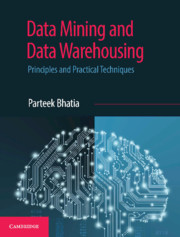Book contents
- Frontmatter
- Dedication
- Contents
- List of Figures
- List of Tables
- Preface
- Acknowledgments
- 1 Beginning with Machine Learning
- 2 Introduction to Data Mining
- 3 Beginning with Weka and R Language
- 4 Data Preprocessing
- 5 Classification
- 6 Implementing Classification in Weka and R
- 7 Cluster Analysis
- 8 Implementing Clustering with Weka and R
- 9 Association Mining
- 10 Implementing Association Mining with Weka and R
- 11 Web Mining and Search Engines
- 12 Data Warehouse
- 13 Data Warehouse Schema
- 14 Online Analytical Processing
- 15 Big Data and NoSQL
- Index
- Colour Plates
1 - Beginning with Machine Learning
Published online by Cambridge University Press: 26 April 2019
- Frontmatter
- Dedication
- Contents
- List of Figures
- List of Tables
- Preface
- Acknowledgments
- 1 Beginning with Machine Learning
- 2 Introduction to Data Mining
- 3 Beginning with Weka and R Language
- 4 Data Preprocessing
- 5 Classification
- 6 Implementing Classification in Weka and R
- 7 Cluster Analysis
- 8 Implementing Clustering with Weka and R
- 9 Association Mining
- 10 Implementing Association Mining with Weka and R
- 11 Web Mining and Search Engines
- 12 Data Warehouse
- 13 Data Warehouse Schema
- 14 Online Analytical Processing
- 15 Big Data and NoSQL
- Index
- Colour Plates
Summary
Chapter Objectives
✓ To understand the concept of machine learning and its applications.
✓ To understand what are supervised and unsupervised machine learning strategies.
✓ To understand the concept of regression and classification.
✓ To identify the strategy to be applied to a given problem.
Introduction to Machine Learning
Machine Learning (ML) has emerged as the most extensively used tool for web-sites to classify surfers and address them appropriately. When we surf the Net, we are exposed to machine learning algorithms multiple times a day, often without realizing it. Machine learning is used by search engines such as Google and Bing to rank web pages or to decide which advertisement to show to which user. It is used by social networks such as Facebook and Instagram to generate a custom feed for every user or to tag the user by the picture that was uploaded. It is also used by banks to detect whether an online transaction is genuine or fraudulent and by e-commerce websites such as Amazon and Flipkart to recommend products that we are most likely to buy. Even email providers such as Gmail, Yahoo, and Hotmail use machine learning to decide which emails are spam and which are not. These are only a few examples of applications of machine learning.
The ultimate aim of machine learning is to build an Artificial Intelligence (AI) platform that is as intelligent as the human mind. We are not very far from this dream and many AI researchers believe that this goal can be achieved through machine learning algorithms that try to mimic the learning processes of a human brain.
Actually, ML is a branch of AI. Many years ago researchers tried to build intelligent programs with pre-defined rules like in the case of a normal program. But this approach did not work as there were too many special cases to be considered. For instance, we can define rules to find the shortest path between two points. But it is very difficult to make rules for programs such as photo tagging, classifying emails as spam or not spam, and web page ranking. The only solution to accomplish these tasks was to write a program that could generate its own rules by examining some examples (also called training data). This approach was named Machine Learning. This book will cover state of art machine learning algorithms and their deployment.
- Type
- Chapter
- Information
- Data Mining and Data WarehousingPrinciples and Practical Techniques, pp. 1 - 16Publisher: Cambridge University PressPrint publication year: 2019

